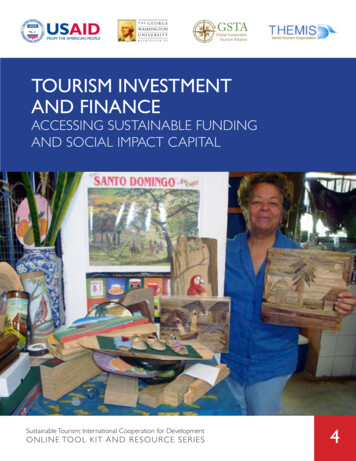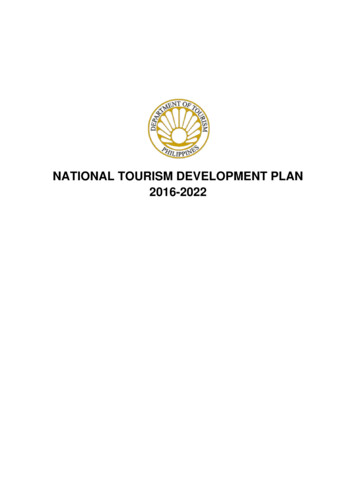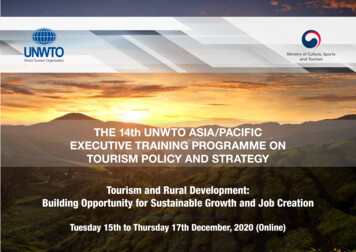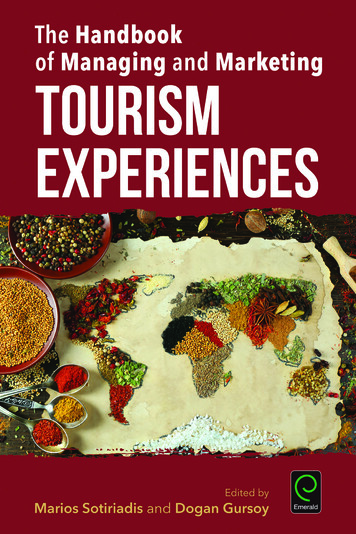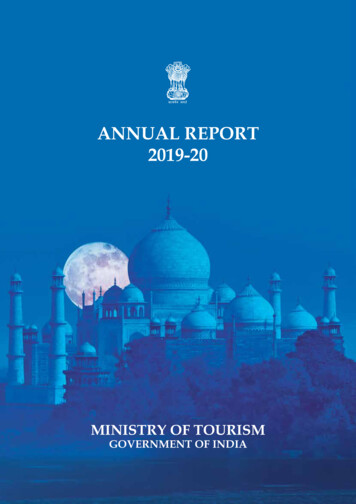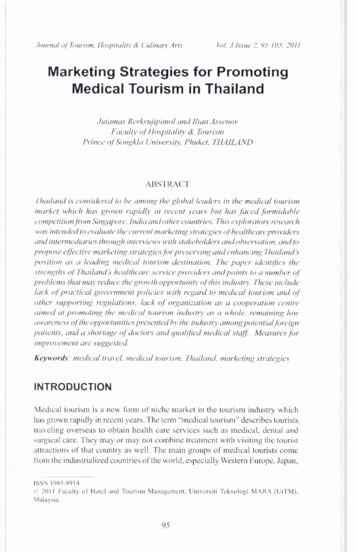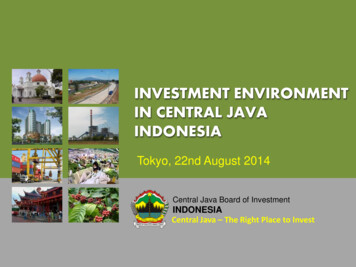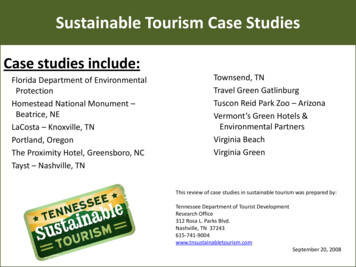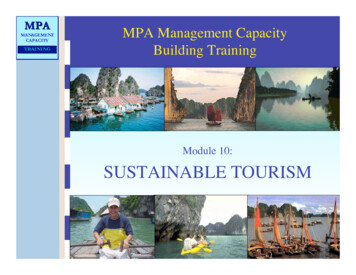
Transcription
MPAMANAGEMENTCAPACITYTRAININGMPA Management CapacityBuilding TrainingModule 10:SUSTAINABLE TOURISM
MPAMANAGEMENTCAPACITYTRAININGOverview of PresentationPART 1:OPPORTUNTIES AND THREATS TO MPAS Sustainable tourism, what does it mean? What are the benefits and threats fromtourism? Is there a demand for sustainable tourism?
MPAMANAGEMENTCAPACITYTRAININGWhat are Today’s Objectives? To identify sustainable tourism mechanismsthat provide conservation, social andeconomic benefits to MPAs and their localcommunities. To determine the most appropriateorganizational structure and support systemfor implementation of an sustainable tourismprogram.
MPAMANAGEMENTCAPACITYTRAININGSustainable Tourism:What does it mean?“Sustainable Tourism” as defined by the WorldTourism Organization (WTO):“Envisaged as leading to management of allresources in such a way that economic, social andaesthetic needs can be fulfilled while maintainingcultural integrity, essential ecological processes,biological diversity and life support systems.”
MPAMANAGEMENTCAPACITYTRAININGWho Benefits from SustainableTourism?Conservation International Has Found: Sustainable tourism projects help forge adirect link between economic benefits andprotection of biodiversity. People who earn their living fromsustainable tourism are more likely toprotect their natural resources and supportconservation efforts.
MPAMANAGEMENTCAPACITYTRAININGWho is Involved inSustainable Tourism?Sustainable tourism encompasses anarray of tourism services and facilitiesincluding:-tourist boats-tourist vendors-small lodges-hotels-tours-government-NGOs- MPAs-communities
leRoleTourismIn AL TOURISM1. Tourist oriented2. Focus on entertainment/refreshment for tourists3. Conservation not apriority4. Communities not apriority5. Quality of tourist servicesand products notstandardizedSUSTAINABLE TOURISM1. Indigenous oriented2. Focus on educationalexperiences & informing3. Conservation of naturalresources a priority4. Foster appreciation forcultural diversity5. Best managementstandards for productsand services
MPAMANAGEMENTCAPACITYTRAININGResearch’s Role InTourism and the EnvironmentResource ProtectionIMPACTS (conventional tourism)1. Depletion/Degradation ofNatural Resourcesimpacts to endangered, stressedor sensitive resources2. Pollutionair emissions, noise, solid waste3. Physical Impactsconstruction, infrastructuredevelopmentCONTRIBUTIONS (sustainable tourism)1. Financial Contributionsdirect and indirect2. Sound Managementdevelopment management3. Environmental Awarenesseducation and outreach4. Protection and Preservationlegislation, regulation
MPAMANAGEMENTCAPACITYTRAININGResearch’s Role InTourism and SocietyResource ProtectionIMPACTS (tourism)1. Changes or Loss of IndigenousIdentity and Valuestreated as a commodity, adaptation2. Cultural Clasheseconomic inequality, behavioraldifferences3. Physical Influences CausingSocial Stressresource use conflicts, culturaldeteriorationCONTRIBUTIONS (ecotourism)1. Strengthening Communitiesjobs created by tourism, reducedemigration, rejuvenated traditions2. Revaluation of Cultureand Traditionsprotection of local heritage
MPAMANAGEMENTCAPACITYTRAININGResearch’s Role InTourism and the EconomyResource ProtectionIMPACTS (tourism)1. Leakagelack of tourist dollars retainedby communityCONTRIBUTIONS (ecotourism)1. Foreign Exchange Earnings2. Contributions to Gov’t Revenues2. Infrastructure CostsTake away from needs such aseducation or health3. Employment Generation4. Contribution to Local Economy3. Increase in Pricesincrease in demand for basic goodsand services at a cost to locals5. Informal Employment
MPAMANAGEMENTCAPACITYTRAININGWho Benefits fromSustainable Tourism? Tourism benefits from having wellmanaged attractions, maintained in theirnatural state. Communities benefit by reaping the socialand economic rewards of long termsustainable tourism. Natural resources are protected for now andfuture generations.
MPAMANAGEMENTCAPACITYTRAININGWhat are the Benefitsfrom Tourism? Revenue Generation-entrance fees, concessions, donations Employment Opportunities-tourism, education, enforcement Justification for MPAs- raises level of importance Awareness Building- visitors, national visitors, localcommunity
MPAMANAGEMENTCAPACITYTRAININGWhat are the Threatsfrom Tourism? Visitor Use- habitats, wildlife, water quality Economic Instability- leakage, social conflict, lack of training Crowding- exceeding carrying capacity Excessive development-infrastructure demands, increase incost of living
MPAMANAGEMENTCAPACITYTRAININGIs There a Demand forSustainable Tourism? 698 million international tourist arrivalsworldwide in 2000 (50 million more than 1999, 7.3%) The fastest developing region is East Asiaand the Pacific (14.6% growth, 16% of total market) In 2000, 2 million visitor arrivals in Vietnam Nature tourism may comprise 40-60% ofmarket, increasing at 10-30% annuallyTaking advantage of this world-wide marketcan bring benefits.It can also bring costs to the community, theenvironment and the economy.
MPAMANAGEMENTCAPACITYTRAININGWhy is Sustainable TourismImportant to “Your” MPA?GROWTH IN TOURISM IN VIETNAM1990-2000YearInt’l ArrivalsGrowth% Growth199019952000250,0001.351 million2.140 million 1.89 million 756%
MPAMANAGEMENTCAPACITYTRAININGWhy is Sustainable TourismImportant to “Your” MPA?Vietnam is a popular tourist destination withthe tourist turnover rate rapidly increasingat an annual rate of over 20%. In 1999,tourist turnover reached VND 175 billion,with total number of tourists reaching 1.1million persons.All human activities carried out in naturalenvironments create impacts.The challenge for ecotourism is to lessen oreliminate the negative impacts on thecommunity and the environment.
MPAMANAGEMENTCAPACITYTRAININGOverview of PresentationPART 2:MANAGING VISITOR IMPACTS Carrying Capacity Best Management Practices Awareness Building
MPAMANAGEMENTCAPACITYTRAININGCarrying CapacityWhat is it?An estimate of how much tourismactivity is acceptable before thedamage that occurs to the environmentand the enjoyment for the visitor issubstantially decreased.
MPAMANAGEMENTCAPACITYTRAININGCarrying CapacityWhy is quantifying difficult?Depends on: ecological conditions resilience of ecosystems behavior of tourists specific activities
MPAMANAGEMENTCAPACITYTRAININGCarrying CapacityLimits of Acceptable Change(LAC) Standards for minimum acceptableconditions Defining limit of ecological or sociologicalchange allowed at site Requires a plan to prevent change beyondlimit Monitoring is essential to determinate pointof management intervention
MPAMANAGEMENTCAPACITYTRAININGCarrying CapacityManagement Responses Seasonal or temporal limits Regulating group size Creating access routes Using zonation Increasing entrance fees at peak periods Constructing facilities that reduce impact,but allow more visitors Awareness building
MPAMANAGEMENTCAPACITYTRAININGBest Management PracticesVisiting Mangroves Construct boardwalk Create fixed paths Encourage snorkeling during slack hightides Used non-motorized vessels Used motorized vessels during high tideonly
MPAMANAGEMENTCAPACITYTRAININGBest Management PracticesVisiting Reefs Reef walks planned in advance, especiallyat low tide Pre-departure briefings Work with tourism providers andcommunity on building awareness Responsible boat management
MPAMANAGEMENTCAPACITYTRAININGAwareness BuildingEnvironmental Education Signage Visitor centers Brochures Events–Lectures–workshops Media
MPAMANAGEMENTCAPACITYTRAININGOverview of PresentationPART 3:THE PLANNING PROCESS What is a sustainable tourism plan? What are the prerequisites? How do you finance a sustainable tourismprogram? Who prepares a sustainable tourism plan? Preliminary Site Evaluation Final Site Diagnostic Data Analysis Phase
MPAMANAGEMENTCAPACITYTRAININGWhat is a SustainableTourism Plan? Must meet the conservation objectives ofthe MPA Guides development of tourism in an MPA Built through community-based process Specific program to be carried out by MPA Defines zoning configuration and access toMPA for tourism
MPAMANAGEMENTCAPACITYTRAININGWhat are the Prerequisites? MPA should have a general a managementplan Commitment to principles of sustainabletourism Funding, technical and logistical support Determination on appropriateness ofsustainable tourism to MPA
MPAMANAGEMENTCAPACITYTRAININGHow to Finance a SustainableTourism Program International Assistance National Sources Local Communities/Governments Tourism Industry
MPAMANAGEMENTCAPACITYTRAININGWho Prepares a SustainableTourism Plan? Tourism professionals Community representatives Government representatives NGOs MPA staff (coordinates)
MPAMANAGEMENTCAPACITYTRAININGStages of Development for aSustainable Tourism Plan PreliminarySite Evaluation Full Site Diagnostic Data Analysis Phase
MPAMANAGEMENTCAPACITYTRAININGOverview of PresentationPART 3:GREEN CERTIFICATION What does it mean?
MPAMANAGEMENTCAPACITYTRAININGWhatResearchare SustainableTourismStrategiesCertification Programs?SUSTAINABLE TOURISM CERTIFICATIONPROGRAMS Voluntary programs that set standards to ensuretourism service and product providers areminimizing impacts to the environment andimproving social and economic conditions of thecommunity. Awarding organization or program recognizes andrewards best practices by including the provider as amember of the certification program.
mResearch StrategiesModels are Already in Place?SUSTAINABLE TOURISM CERTIFICATIONPROGRAMS There are over 100 certification schemes intourism alone. Successful models have also been developedfor industries such as forestry, organicfarming and fishing.
mModelsareStrategiesAlready in Place? Sustainable Tourism Certification Network of theAmericas (Rainforest Alliance) SmartVoyager Certification (Conservacion yDesarollo and Rainforest Alliance) World Legacy Awards (Conservation Internationaland Nat’l Geo Traveler Magazines) Ecotourism Australia NEAP Certification The International Ecotourism Society Institute of Policy Studies UNEP and The World Tourism Organization Vietnam, Cambodia, China?
MPAMANAGEMENTCAPACITYTRAININGWhatCan CertificationResearchStrategiesDo? Set standards to ensure impacts from tour operationsare minimized Help communities develop more economically andenvironmentally viable products and services basedon best practices Develop and maintain unified conservation themesand messages (marketing) Opportunity to share information and build demand Provides for international recognition Increases fundraising potential Provides for participation in international network
archCan Certification Recognizes and rewards best practices Ensures the tourism industry is held accountable Assures travelers they are supporting operators whoact responsibly and are helping to make acontribution to the protection of the environment,conservation, and the social well being ofindividuals and local communities
rch StrategiesCertification Program Provide? Developing marketing skills and identity Preparing for certification Incorporating best management practices into allaspects of products and services Identifying funding sources Identifying sustainable tourism markets Raising awareness on benefits of certification totourism operators, tourists and local communities
MPAMANAGEMENTCAPACITYTRAININGWhat isResearchthe RoleStrategiesof Governmentin a Certification Program? Clarify the government’s role in tourism andconservation management Establish a policy and legislative framework thatsupports ecotourism Design, develop and regulate an environmentallysensitive infrastructure Require environmental impact statements fordevelopment projects Develop economic instruments to supportecotourism such as incentives, taxes, departure fees
MPAMANAGEMENTCAPACITYTRAININGWhat isResearchthe RoleStrategiesof Governmentin a Certification Program? Allocate tax revenues for the protection ofecotourism attractions such as parks andreserves Earmark adequate funding for resources for themanagement of protected areas Provide critical support for private sectorvoluntary initiatives such as certificationprograms Promote and develop education programs toenhance awareness of conservation
MPAMANAGEMENTCAPACITYTRAININGWhat isResearchthe RoleStrategiesof Stakeholdersin a Certification Program? Help to establish a standard for conservation and socialwelfare To uphold the standards of the certification program To be accountable and assume responsibilities intourism and conservation partnerships To be willing to make a long term commitment to thecommunity and conservation To collaborate on visitor awareness campaigns,outreach and marketing efforts To communicate about experience and share expertise To become an informed decision maker thatparticipates in all aspects of ecotourism development
MPAMANAGEMENTCAPACITYTRAININGResearchWhat isthe RoleStrategiesof the Tourist? Learn about your destination before you get there - besensitive to the customs, traditions and culture; and theenvironment Seek out ecotourism certified services and products ensure maximum community and conservationbenefits from tourist dollars Follow establishedguidelines- consult withecotourism operators andguides on ways to minimizeimpacts on sensitive areas
MPAMANAGEMENTCAPACITYTRAININGResearchCaseStudy I:StrategiesGalapagosECUADOR’S GALAPAGOS ISLANDS Tour operators, naturalist guides, park officials andscientists worked together to create a model for lowimpact, high quality ecotourism. 62,000 people per year pay to dive, tour and cruiseamidst the 120 volcanic islands Tourism raises as much as USD 460 million annually,and provides income for an estimated 80% of theislands residents Ten fold increase since 1970 has expanded theresources for Ecuador's park service.
MPAMANAGEMENTCAPACITYTRAININGResearchCaseStudy I:StrategiesGalapagosECUADOR’S GALAPAGOS ISLANDS Attracted a flood of immigrants seeking jobs in theislands’ new tourist economy Only 15% of the tourist income enters the Galapagoseconomy Hordes of tourists have brought new threats andimpacts to the islands Of the USD 43 million the Galapagos National Parkgenerates each year, only 20% goes to the national parksystem
sibleResearch StrategiesSolutions?Discuss as a group What is wrong with the Galapagossystem? How could it be improved or mademore sustainable?
ple SolutionsBELIZE Raises funds for conservation through a USD 3.75tourist tax levied on every foreign visitor as they departthe country, generating USD 750,000 per year used forconservation.KENYA 25% of the entrance fees is shared with communitiesbordering protected areas. Ecotourism plannersadvocate sales of local handicrafts, patronage of locallodges, use locally grown food in restaurants. Training programs have enabled residents to fillpositions as tour guides, lodge managers and parkrangers.
MPAMANAGEMENTCAPACITYCaseStudy II:AustraliaResearchStrategiesTRAINING NATURE-BASED ECOTOURISM CERTIFICATIONPROGRAM (NEAP)Australia-wide, started 1996Voluntary, only motivated operators applyFee basedRequires interpretation, monitoring, impactmanagement and contributions to conservationRequired in some protected areasField tested in 50 sitesRecognizes and rewards best management33% operators claimed increased business92% said they would renew their certification
MPAMANAGEMENTCAPACITYTRAININGCase Study III: DemonstrationResearchStrategiesProjectLINKING CONSERVATION AND TOURISM AT SIXWORLD HERITAGE SITES Brings together conservation education, planning,business development and marketing Involves communities to create better tourism productsand sustainable management systems Develops partnerships between protected areas,managers and the private sector In third year of implementation and has supportedtraining of 51 nature guides and 22 ecotourismpromoters at 4 World Heritage Sites
MPAMANAGEMENTCAPACITYTRAININGCase Study III: DemonstrationResearchStrategiesProjectLINKING CONSERVATION AND TOURISM AT SIXWORLD HERITAGE SITES(Guatemala, Mexico, Honduras, Indonesia) Expected results include: enhanced staff capabilities,clear tourism strategies, active support from thetourism industry, increased revenues, widespreadbenefits to local people Support by Aveda, the global cosmetics firm whichdonated 500,000, funds to be matched by the UnitedNations Foundation
MPAWaystoGetInvolvedinResearch StrategiesSustainable TourismMANAGEMENTCAPACITYTRAINING5 WAYS TO PARTICIPATE IN SUSTAINABLETOURISM:1.2.3.4.5.Modify an existing tourism business to meetecotourism objectivesMake an alliance with an existing enterpriseproducing a tourism product or serviceStart an ecotourism enterpriseInvest in ecotourismSupport efforts of ecotourism (directly or indirectly)
MPAMANAGEMENTCAPACITYTRAININGSteps for Developing a rogramSERIES OF WORKSHOPS TO INCLUDE: Work with community to evaluate need and interest Conduct rapid analysis of ecotourism realities andpotential of region Conduct assessment of resources (capital), markets andcapacity Form Certification Council (stakeholder-based) Develop clearly articulated goals and objectives Establish guidelines for best practice in terms ofquality and sustainability Identify ecotourism markets
MPAMANAGEMENTCAPACITYTRAININGSteps for Developing a SustainableResearchStrategiesTourism Certification Program Identify economic instruments (fees, taxes, incentives) Identify funding sources Establish evaluation/impact assessment system andstandards Develop marketing plan Establish independent audit system Train tourism providers to meet certification standards Develop implementation plan Field test/ pilot sites Establish framework for creating ecotourism policies atthe regional and national level
MPAMANAGEMENTCAPACITYTRAININGWhoResearchNeeds toStrategiesParticipate toMake it Work?Proper management of tourism to ensure bothsocial and environmental benefits requirescollaboration among:1. Public Agencies2. Private Sector3. Local Communities
sTRAININGSOURCES OF INFORMATION Wendy Vanasselt, Ecotourism and Conservation: Are They Compatible?, World Resources,2000-2001Tourism and Biodiversity: Mapping Tourism’s Global FootprintUNEP, Production and Consumption BranchRainforest Alliance, Sustainable Stewardship Tourism CouncilInternational Ecotourism SocietyConservation InternationalPROARCA, Best Management Practices for Sustainable Tourism
Carrying Capacity Best Management Practices Awareness Building MPA MANAGEMENT CAPACITY TRAINING. Carrying Capacity What is it? An estimate of how much tourism activity is acceptable before the damage that occurs to the environment and the enjoyment for the visitor is substantially decreased. MPA MANAGEMENT CAPACITY TRAINING. Carrying Capacity Why is quantifying difficult? Depends .
